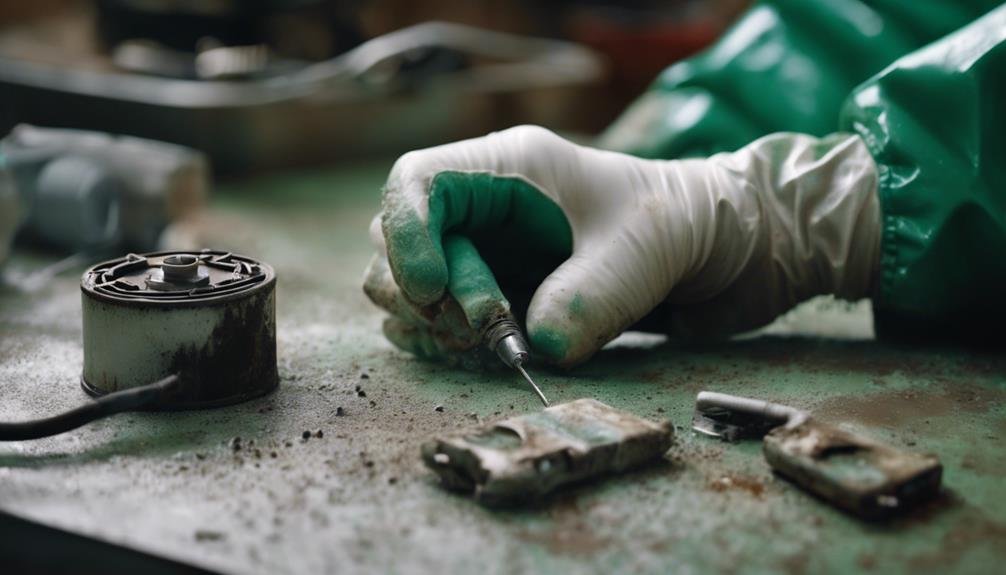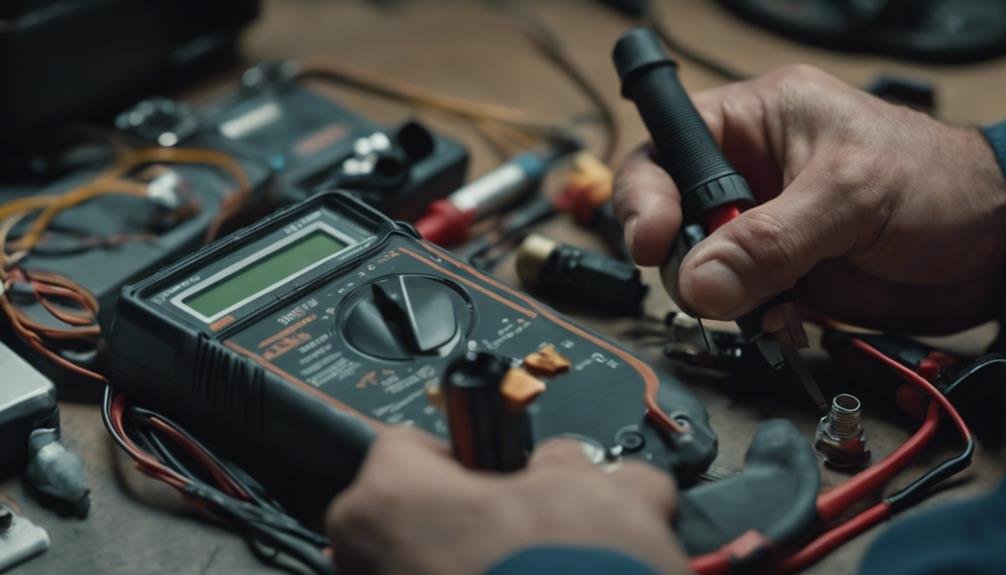To clean battery terminals properly, prepare by donning protective gear, creating a essential solution, and gathering necessary tools. Disconnect the negative battery cable initially, then inspect terminals for corrosion, leaks, or damage. Remove corrosion and grime using a wire brush and baking soda solution, rinse thoroughly, and dry completely. Apply a protective coating like petroleum jelly to prevent corrosion. Reconnect terminals in reverse sequence, ensuring secure connections. Regular maintenance is vital, so check terminals regularly, tighten loose connections, and apply protective sprays to prolong battery life. Now that you've started, you'll want to learn more about maintaining your battery's top-notch performance.
Key Takeaways
- Wear protective gear, including gloves and safety glasses, to prevent injury from hazardous substances and electrical shock.
- Disconnect the negative battery cable first to prevent short circuits, and inspect terminals for corrosion buildup and damage.
- Mix baking soda and water to create a cleaning solution, and scrub terminals with a wire brush or toothbrush while wearing eye protection.
- Rinse terminals thoroughly with water, dry completely, and apply petroleum jelly to prevent corrosion and improve electrical flow.
- Regularly clean and maintain terminals to prevent corrosion, tighten loose connections, and apply protective coatings to prolong battery lifespan.
Prepare for Cleaning
Before you start cleaning your battery terminals, put on protective gear like gloves and safety glasses to shield yourself from corrosive materials that might be lurking on the terminals.
You'll be working with potentially hazardous substances, so it's important to prioritize your safety. Corrosion on your battery terminals can lead to electrical issues, so it's vital to clean them regularly.
To prepare for cleaning, mix baking soda and water to create a neutralizing solution that will help break down corrosion. This solution will prevent further corrosion and allow you to clean the terminals effectively.
Make sure you have a wire brush handy for lead battery posts and a plastic brush for detailed cleaning. By taking these preliminary steps, you'll be well-equipped to tackle the cleaning process and ensure your battery terminals are in top condition.
Disconnect and Inspect
You'll need to disconnect the negative battery cable initially to prevent electrical shock, so locate the negative terminal and loosen the nut that holds the cable. Once you've disconnected the negative cable, inspect the terminals for visible corrosion buildup, which can hinder battery performance. Look for any signs of corrosion, such as a flaky white or greenish substance, and take note of its severity.
Check for signs of leaks, swelling, or bloating on the battery, which may indicate issues beyond corrosion.
Inspect the battery cables for any fraying, damage, or loose connections that may need fixing during the cleaning process.
Take a close look at the terminals and cables for signs of wear or damage that may require professional attention.
Remove Corrosion and Grime

Securing corrosion and grime from your battery terminals is a crucial step in maintaining their performance, and it starts with creating a cleaning solution by mixing baking soda and water. This mixture will help break down and remove corrosion and grime that has built up on your terminals.
Next, use a wire brush or toothbrush to scrub the terminals, paying special attention to the areas around the battery posts and the positive cable. Be sure to wear eye protection to avoid any debris from getting in your eyes. As you scrub, focus on removing any corrosion, grime, or buildup that's accumulated on the terminals.
Once you've thoroughly cleaned the terminals, rinse them with water to remove the cleaning solution and any remaining debris. Lastly, dry the terminals completely with a clean rag to prevent any moisture from causing future corrosion. Apply a thin layer of petroleum jelly to the terminals to protect against future corrosion and ensure a good electrical connection.
Neutralize and Rinse
Now that the corrosion and grime have been scrubbed away, it's important to neutralize the affected area by rinsing the terminals thoroughly with water to remove any residue from the cleaning process. This step is vital in preventing further corrosion and ensuring peak battery performance.
To neutralize the corrosion, you can use a baking soda-water mixture, which helps to counteract the acidic properties of the corrosion. After neutralizing, rinse the terminals thoroughly with water to remove any residue from the cleaning process.
Here are some key points to keep in mind:
- Neutralize the corrosion with a baking soda-water mixture to prevent further damage.
- Rinse the terminals thoroughly with water to remove any residue from the cleaning process.
- Make sure the terminals are completely dry before reconnecting to prevent electrical issues.
Dry and Inspect Terminals

After neutralizing and rinsing the terminals, take a clean cloth to thoroughly dry them, ensuring no moisture remains that could cause electrical issues. It's important to eliminate any remaining moisture, as it can lead to corrosion or short circuits. Dry the terminals with a gentle, sweeping motion, paying attention to the crevices and corners where moisture tends to accumulate.
Next, inspect the battery terminals for any signs of damage, corrosion, or wear. Check the connections for any loose or frayed wires, which can compromise the electrical connection. Inspect the terminals themselves for corrosion, rust, or mineral buildup, addressing any issues promptly to prevent further damage.
Regular maintenance is key to extending the life of your battery. By taking the time to dry and inspect your terminals, you can identify potential problems before they become major issues. Remember, clean and dry terminals are important for reliable electrical connections and top battery performance.
Apply Protective Coating
With your terminals dry and inspected, you can further protect them from corrosion by applying a protective coating. This step is essential in preventing corrosion and ensuring peak electrical flow.
Petroleum jelly is a popular and effective option for this purpose. When applied to the terminals, it creates a moisture barrier that prevents corrosion-causing contaminants from coming into contact with the metal.
Here are some benefits of applying a protective coating:
- Prevents corrosion and prolongs the lifespan of the battery terminals
- Improves electrical flow by reducing resistance between the terminals and cables
- Creates a barrier against moisture and contaminants that can lead to corrosion
Reconnect and Check

Once you've applied a protective coating, reconnect the battery terminals in the reverse order of disconnection, starting with the positive terminal, to prevent sparking. Make sure they're securely tightened to avoid electrical issues and poor connections.
Before starting the vehicle, double-check that there's no leftover corrosion or debris on the terminals. Take a close look to verify everything is clean and clear.
Next, test the battery to confirm that the cleaning process was successful and that the terminals are functioning properly. Turn the key and listen for the engine to roar back to life. If it doesn't, you may need to revisit the cleaning process or consult a professional.
Maintenance and Prevention
To guarantee your hard work pays off, you'll want to make maintenance and prevention a regular part of your battery care routine. By doing so, you'll prevent corrosion buildup, ensuring proper electrical flow and peak battery performance.
Here are some crucial tips to keep in mind for effective battery maintenance:
- Regularly cleaning the terminals and applying a thin layer of petroleum jelly can prevent corrosion and improve conductivity, prolonging battery life.
- Tightening loose connections and applying protective sprays or terminal protectors can prevent future issues and ensure proper electrical flow.
- Checking the battery regularly for signs of corrosion and parking in a cool, dry area can help prevent damage to the battery terminals.
Frequently Asked Questions
What Is the Best Thing to Clean Battery Terminals With?
You're wondering what's the best thing to clean battery terminals with? Well, it's a baking soda paste, which neutralizes corrosion and breaks it down effectively, making it the top choice for a safe and efficient cleaning process.
How Do You Remove Battery Corrosion From Battery Terminals?
You remove battery corrosion from terminals by applying a baking soda paste, letting it sit, then scrubbing with a wire brush and rinsing; this neutralizes and removes corrosion, ensuring a clean connection.
Is WD-40 Good for Cleaning Battery Terminals?
You're wondering if WD-40 is good for cleaning battery terminals? While it can neutralize corrosion temporarily, it's not a long-term solution, and dedicated cleaners might be a better option for more effective results.
Can You Clean Battery Terminals Without Disconnecting?
You shouldn't clean battery terminals without disconnecting, as it's risky and can cause electrical hazards. Instead, disconnect the battery cables to guarantee your safety and a thorough cleaning process.
Conclusion
You've successfully cleaned your battery terminals, ensuring a reliable connection and peak performance. By following these steps, you've removed corrosion, grime, and acid residue, and applied a protective coating to prevent future buildup.
Regularly inspect and maintain your terminals to prevent issues, and consider using a battery maintainer or trickle charger to keep your battery healthy.
With clean terminals, your vehicle's electrical system will function efficiently, and you'll avoid costly repairs down the road.
